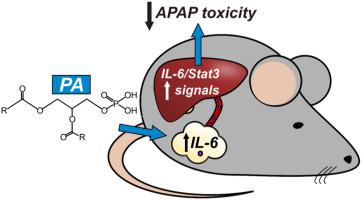Acta Pharmaceutica Sinica B ( IF 14.5 ) Pub Date : 2021-08-26 , DOI: 10.1016/j.apsb.2021.08.024 Melissa M Clemens 1, 2 , Stefanie Kennon-McGill 3 , Joel H Vazquez 1, 2 , Owen W Stephens 4 , Erich A Peterson 4 , Donald J Johann 4 , Felicia D Allard 5 , Eric U Yee 5 , Sandra S McCullough 6 , Laura P James 6 , Brian N Finck 7 , Mitchell R McGill 1, 3, 8

|
We previously demonstrated that endogenous phosphatidic acid (PA) promotes liver regeneration after acetaminophen (APAP) hepatotoxicity. Here, we hypothesized that exogenous PA is also beneficial. To test that, we treated mice with a toxic APAP dose at 0 h, followed by PA or vehicle (Veh) post-treatment. We then collected blood and liver at 6, 24, and 52 h. Post-treatment with PA 2 h after APAP protected against liver injury at 6 h, and the combination of PA and N-acetyl-l-cysteine (NAC) reduced injury more than NAC alone. Interestingly, PA did not affect canonical mechanisms of APAP toxicity. Instead, transcriptomics revealed that PA activated interleukin-6 (IL-6) signaling in the liver. Consistent with that, serum IL-6 and hepatic signal transducer and activator of transcription 3 (Stat3) phosphorylation increased in PA-treated mice. Furthermore, PA failed to protect against APAP in IL-6-deficient animals. Interestingly, IL-6 expression increased 18-fold in adipose tissue after PA, indicating that adipose is a source of PA-induced circulating IL-6. Surprisingly, however, exogenous PA did not alter regeneration, despite the importance of endogenous PA in liver repair, possibly due to its short half-life. These data demonstrate that exogenous PA is also beneficial in APAP toxicity and reinforce the protective effects of IL-6 in this model.
中文翻译:

外源性磷脂酸通过器官间串扰激活肝白细胞介素 6 信号,减轻对乙酰氨基酚诱导的小鼠肝损伤
我们之前证明,内源性磷脂酸 (PA) 可促进对乙酰氨基酚 (APAP) 肝毒性后的肝再生。在这里,我们假设外源性 PA 也是有益的。为了测试这一点,我们在 0 小时用有毒的 APAP 剂量处理小鼠,然后进行 PA 或载体 (Veh) 后处理。然后我们在 6、24 和 52 小时收集血液和肝脏。在 APAP 后 2 小时用 PA 后处理在 6 小时保护免受肝损伤,以及 PA 和N-乙酰基-1的组合-半胱氨酸 (NAC) 比单独使用 NAC 更能减少伤害。有趣的是,PA 不影响 APAP 毒性的典型机制。相反,转录组学显示 PA 激活了肝脏中的白细胞介素 6 (IL-6) 信号。与此一致,在 PA 处理的小鼠中,血清 IL-6 和肝信号转导和转录激活因子 3 (Stat3) 磷酸化增加。此外,PA 未能在 IL-6 缺陷动物中防止 APAP。有趣的是,PA 后脂肪组织中 IL-6 的表达增加了 18 倍,表明脂肪是 PA 诱导的循环 IL-6 的来源。然而,令人惊讶的是,尽管内源性 PA 在肝脏修复中很重要,但外源性 PA 并没有改变再生,这可能是由于其半衰期短。



























 京公网安备 11010802027423号
京公网安备 11010802027423号